1880-1889 - Centennial extravaganza - Coins and medals - Timeline and pictures
By Museum Victoria | Thursday, 22 November 2007
Melbourne was booming in the 1880s and joined the international world's fair circuit to showcase its prosperity as a colony. The Centennial Exhibition in 1888 celebrated 100 years since the arrival of the First Fleet. During this period, awards won at international exhibitions were a valuable marketing tool. In Melbourne, the gold medals were actually made of pure gold.
Gold Medal Melbourne International Exhibition, 1880
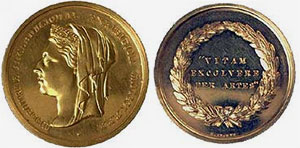
This medal was won by the British armaments firm, Armstrong & Co. which hoped to sell weapons to defence forces in the colonies. The Melbourne International Exhibition medals were actually made from gold unlike many 'gold' medals of the era, which were gold plated. The firm had previously won a gold medal at the Sydney exhibition in 1879 for the same exhibit.
Obverse - Veiled head of Queen Victoria around which is legend MELBOURNE INTERNATIONAL EXHIBITION MDCCCLXXX.
Reverse - The Latin legend VITAM EXCOLVERE PER ART.
Melbourne Hippodrome medal, 1881
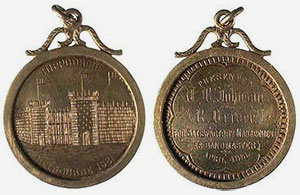
This engraved silver medal was presented to the bandmaster of the Melbourne Hippodrome in 1881. The Hippodrome was an entertainment facility that stood on the south bank of the Yarra on St Kilda Road.
Obverse - An engraving of the front of the Hippodrome with the word HIPPODROME above and MELBOURNE 1881 below.
Reverse - The engraving PRESENTED TO T.B. JOHNSON FROM R. DRIVER FOR SATISFACTORY MANAGEMENT AS BANDMASTER APRIL 1881.
The Victoria Medal, 1882
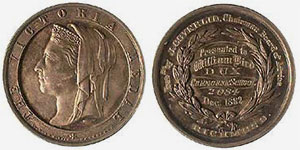
This is a school prize medal that features a portrait of Queen Victoria (artistically based on the head on the 1880 Melbourne Exhibition prize medal). This silver example was won by William Bird, the dux of the Cremorne School, Richmond in 1882.
Obverse - Veiled head of Queen Victoria facing left with the legend THE VICTORIA MEDAL around on a broad rim. The maker's name, STOKES AND MARTIN MELBOURNE, can be seen in small letters at the bottom of the medal.
Reverse - The medal was struck with a simple wreath on the reverse. The school had it inscribed: Presd. By J. CLOVERLID, Chairman, Board of Advice. Presented to William Bird DUX CREMORNE SCHOOL 2084 Dec. 1882 RICHMOND.
Picnic prize medal, 1883
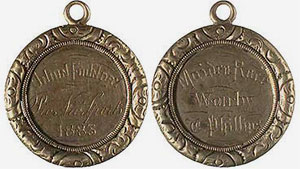
This small silver medal was prepared for the annual company picnic of the Union Foundry in 1883. It was awarded for the 'Maiden Race' and was won by T. Phillips. The Union Foundry was started in Ballarat in 1863 to manufacture retorts for the local gas company, machinery for the Ballarat Meat Preserving Company and heavy castings for the Queensland sugar industry.
Obverse - Inscribed, UNION FOUNDRY Pic Nic Sports 1883.
Reverse - Inscribed, Maiden Race Won by T. Phillips.
Victorian Volunteer Forces Long Service Medal, 1883
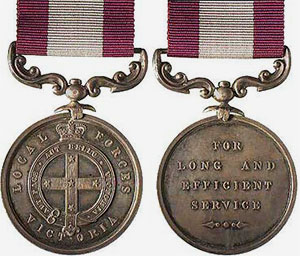
The Victorian Volunteer Forces were the local regiments who undertook the naval and military defence of the colony of Victoria. This example of their Long Service Medal was awarded to A Geddes in 1883. After Federation in 1901, this medal became obsolete.
Obverse - At the centre of the medal is a cross bearing the stars of the Southern Cross. Around the Cross is a belt with a crown at the top. On the belt is the Latin motto of the Forces, AUT PACE AUT BELLO VICTORIA [Either in peace or in war, Victoria], and around it the legend LOCAL FORCES VICTORIA.
Reverse - The legend FOR LONG AND EFFICIENT SERVICE.
Melbourne Wharf Labourers check, 1885
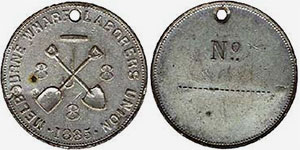
This is an unissued check piece produced for the Melbourne Wharf Labourers Union in 1885. It features a bale hook, spade and shovel separating the Eight-hour movement's 888 (representing 8 hours work, 8 hours recreation and 8 hours rest). Check pieces like this were a form of identification of members.
Obverse - At the centre are crossed tools separating the numbers 888. Around this is the legend MELBOURNE WHARF LABOURERS UNION 1885.
Reverse - No. ----------. If the check had been issued, a member's number would be stamped above the dotted line.
Crown (Five Shillings), 1887
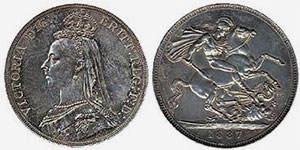
This is one of a series of coins featuring the Jubilee head of Queen Victoria by the medallist and gem-engraver Sir Joseph Edgar Boehm. About this portrait the authority L. Forrer wrote 'Unfortunately, his head of Queen Victoria was so much wanting in artistic merit that it was severely criticised by all experts, and never gained favour with the public'. This head was replaced on the coinage in 1893.
Obverse - Crowned and veiled bust of Queen Victoria facing left. Around this the legend VICTORIA D:G:BRITT:REG: F:D: [Victoria by the Grace of God Queen of the Britons, Defender of the Faith].
Reverse - Pistrucci's famed depiction of St. George and the dragon with the date 1887 below.
Medals of Melbourne International Exhibition, 1888
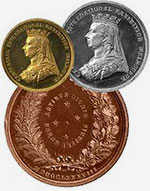
These are the gold, silver and bronze medals awarded as prizes and for services by the Melbourne 1888 International Exhibition. This exhibition marked the centenary of European settlement of Australia. The gold medal was won by the Flemington Meat Preserving Company, the silver by David Winbanks and the bronze by the wine maker Thomas Fiaschi.
Obverse - Crowned and veiled bust of Queen Victoria facing left. Around it is the legend CENTENNIAL INTERNATIONAL EXHIBITION MELBOURNE.
Reverse - Around the Southern Cross and within a wreath of wattle and oak leaves is the Latin legend ARTIBUS DIGNIS HONOR INSIGNIS [To the deserving arts distinguished honour]. Below the wreath is the date MDCCCLXXXVIII [1888].
Eiffel Tower medal, 1889
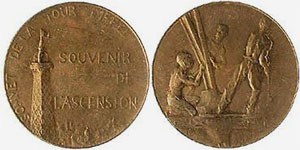
In 1888 the French sent a major exhibit to Melbourne, it included a large model of the Eiffel Tower, then being built for the Paris International Exhibition in 1889. They hoped to attract Australian entries for the forthcoming Paris Exhibition. This medal was a souvenir for those who reached the top of the Eiffel Tower during the Exhibition year. It was possibly brought back to Melbourne by a Victorian exhibitor at Paris.
Obverse - The top of the Eiffel Tower and a view across Paris, with the French legend SOUVENIR DE L'ASCENSION SOMMET DE LA TOUR EIFFEL [Souvenir of ascending to the top of the Eiffel Tower].
Reverse - Three workmen constructing a section of the tower.
Melbourne Total Abstinence medal, about 1890
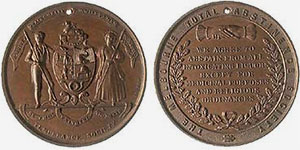
This is a medal of the Melbourne Total Abstinence Society. The Society was one of several organisations in nineteenth century Victoria established to promote temperance, oppose the extension of hotel licences, and educate children and adults about the dangers of alcohol. Others were the Order of the Sons of Temperance, the International Order of Good Templars, and the Band of Hope.
Obverse - The arms of the Temperance Society supported by a husband, holding a flag inscribed SOBRIETY, and a wife, holding a flag inscribed DOMESTIC COMFORT. Above them on a ribbon is the legend PEACE ON EARTH AND GOOD WILL TO MEN. Below the on another ribbon is BE THOU FAITHFUL UNTO DEATH. At the base of the medal is the legend TEMPERANCE SOCIETY.
Reverse - Around the medal on a wide border is the legend THE MELBOURNE TOTAL ABSTINENCE SOCIETY. At the centre within a wreath of oak branches and below a pair of shaking hands is the vow WE AGREE TO ABSTAIN FROM ALL INTOXICATING LIQUORS EXCEPT FOR MEDICINAL PURPOSES AND RELIGIOUS ORDINANCES.
Cycling medals, 1890s
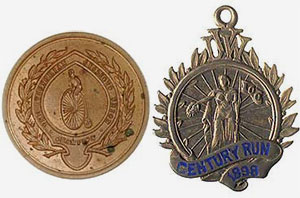
The cycle racing craze of the 1890s saw the replacement of the penny-farthing as the racing cycle of choice by cycles of a more modern appearance. In 1891 the Exhibition Buildings constructed the colonies main cycle racing track where the entrance foyer of Museum Victoria now stands. The governing body of the sport was at that time the League of Victorian Wheelmen.
First medal Obverse - Within a wreath of olive and laurel branches is a shield bearing the legend THE VICTORIAN CYCLISTS UNION CHAMPION. At the centre is a cyclist on a penny-farthing bicycle.
Second medal Obverse - The medal, with a loop for wearing, is made up of a wheel set on a victory wreath. At the top are the letters LVW (League of Victorian Wheelmen). A female figure, perhaps representing the colony of Victoria, holds a flag inscribed "100" and offers a wreath. Enamelled in blue is the legend CENTURY RUN 1898.
Chinese Chamber of Commerce medal, about 1891

This is one of a small group of membership medals of the Chinese Chamber of Commerce which appeared in trade in the late 1880s and early 1890s.
Obverse - Chinese inscription around a flag.
Reverse - At the centre is a Chinese legend with three Chinese characters inscribed above it. Around this on a broad rim is the legend CHINESE CHAMBER OF COMMERCE VICTORIA.
Eight Hours Committee badge, 1891
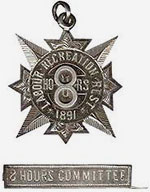
This star-shaped badge would originally have hung from a ribbon linking the bar 8 HOURS COMMITTEE to the badge itself. It is a silver membership badge of the 1891 Eight Hours Committee which co-ordinated the annual Eight-hours Day celebrations.
Obverse - The centre of the badge features a large number 8 breaking up the word HOURS (the U is below the 8). Around this is the inscription LABOUR RECREATION REST 1891.
Colombian Exhibition prize medal, 1892
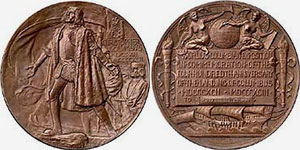
The Colony of Victoria sent a number of exhibits to the Columbian Exposition in 1892. This was one of the great International World's Fairs of the 19th century. Held in Chicago, it celebrated the 400th anniversary of Columbus' discovering the Americas. Among the Victorian entries were two exhibits entered by women's groups. The Museum holds the medals awarded to for these - one awarded to the Women of Victoria and this one to the Women of Melbourne.
Obverse - Christopher Columbus is depicted stepping ashore in the Americas being followed by a flag-bearing soldier and a man who may be a merchant. Behind them is the legend CHRISTOPHER COLVMBVS OCT. XII MCCCCXCII.
Reverse - Two winged Victories seated on plaque, one calling the world with a trumpet and the other pointing to a globe with a pen. The plaque is set above Columbus' ship and is flanked by torches. On the plaque is the legend WORLD'S COLUMBIAN EXPOSITION IN COMMEMORATION OF THE FOUR HUNDREDTH ANNIVERSARY OF THE LANDING OF COLUMBUS MDCCCXCII - MDCCCXCIII TO WOMEN OF MELBOURNE.
Crown (five shillings), 1894
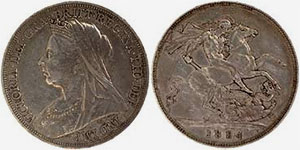
This crown (five shilling) bears the final coin portrait of Queen Victoria by the sculptor Thomas Brock. It was used on all coins British from 1893 until 1901, including the gold sovereigns and half sovereigns struck in Australia.
Obverse - Veiled head of Queen Victoria facing left. Around it is the Latin legend VICTORIA DEI GRA: BRITT: REGINA FID: DEF: IND: IMP: [Victoria by the Grace of God Queen of the Britons, Defender of the Faith, Empress of India].
Reverse - Pistrucci's image of St George and the dragon with the 1894 below.
VAAA gold medal, 1899
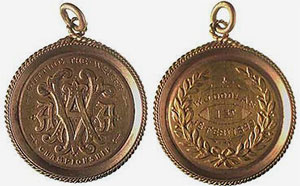
This is a gold medal awarded by the Victorian Amateur Athletics Association in 1899 to the winner of the competition "Putting the Weight" (now the shot put). It was won by WJ Doolan.
Obverse - At the centre is the monogram VAAA (Victorian Amateur Athletics Association) above the word CHAMPIONSHIP.
Reverse - Above the monogram the words PUTTING THE WEIGHT have been inscribed. Reverse - W.J.DOOLAN 1ST. 18 FEBY. 1899 is engraved within a wreath.



